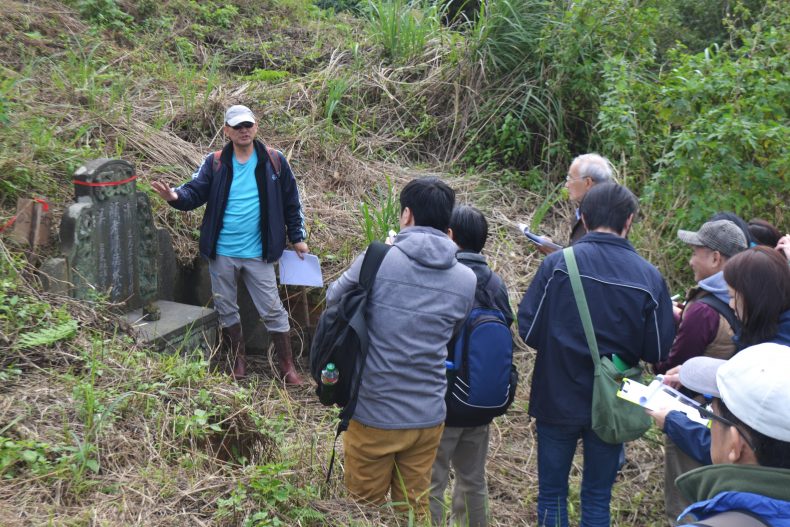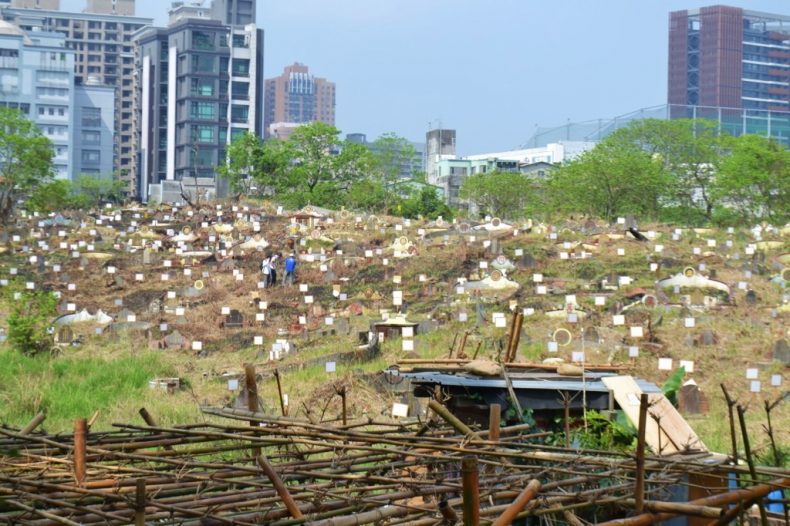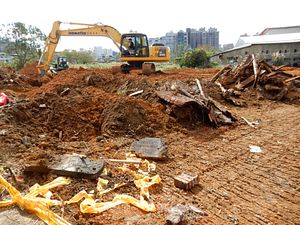Taiwan has a problem with preserving its cultural assets. Despite a rich documented history spanning nearly four centuries of European, Ming, Qing, Japanese, and Republican conquest, each successive administrative government sought to stamp out traces of the previous regime while establishing its own. Understandably many of Taiwan’s cultural assets and heritage sites have been lost due to activities in the past. But today, 30 years after the end of martial law, and 20 years after democratization, in a period where the Taiwanese are free to proudly discuss and display their heritage, there is still a systemic attempt to destroy its ancient, colonial, and cultural artifacts.
Today’s destructive force is development, and the perverse tragedy of modern Taiwan is that in its push to be recognized as a great modern nation, priority is taken away from the cultural assets that give it its identity. The forces of local planning and popular consumption have framed a path that a small but growing voice of preservationists are attempting to pull the island away from, highlighting a split in the debate over Taiwan’s future.
The latest battleground over Taiwan’s future is a cemetery in New Taipei City’s Xindian District. The cemetery was once home to more than 5,000 tombs, many dating to the Qing Dynasty and Japanese colonial period, which, due to terrain constraints, has preserved the traditional worship practices of local families for nearly three centuries. The cemetery is in the process of being demolished to make room to expand Xindian’s industrial cluster, a move that preservationists argue will destroy the district’s anchor to its past. A devastating flood in the early 20th century destroyed much of the district’s buildings from the Qing Dynasty and Japanese colonial period, leaving Xindian First Public Cemetery as one of the area’s oldest remaining sites.
Taiwanese cultural preservation traces its beginnings to the early 1990s, during a period when development and economic priorities at government and grassroots levels were eclipsing attempts to list important local sites. The result was that Taiwanization was ignored in favor of the market and short-term economic gains.
“By this time a hot real estate market and fast modernization made every piece of land a potential bonanza,” explains Linda Arrigo, a Taiwan-based American human rights activist and professor emeritus at Taipei Medical University.
The resulting real estate boom meant that families opted to demolish their ancient family mansions before they could be put on a historic register in order to free up the more valuable land for sale. In other cases ornamentation was removed and sold for profit, destroying a potentially listed house’s cultural value. Whatever the means, Taiwanese developers were able to feed the hungry market, while historical sites went under the bulldozer. This destruction continues today.
“The economic powers — both public and private — often destroy things so that there will be no issue of preservation that will get in the way of realizing their development projects and profits. There have been some very ugly cases in the past,” comments Arrigo.
The 2006 removal of some 800 trees from the former Songshan Tobacco Factory Park and the subsequent death and disposal of 103 trees by city developers created an outcry among activists. The factory had previously maintained a large park for public use on the premises until the facility shut down, and the land was contracted for development into the Taipei Dome arena. Many of the dead trees are suspected to have been legally protected, but were removed by city officials before lawyers could determine their age and whether or not a crime had been committed. Many local residents assumed the park would be rehabilitated for use, and only recognized what was lost once the sports facility was underway.
The dominance of development forces has meant that preservation efforts mainly focus on a synthesis with tourism development. This dynamic has given Taiwan its many historic old streets, which have become a draw for small businesses and retail outlets. They fit with the Taiwanese love of “re-nao,” hot, noisy scenes and street food. If cultural heritage can’t fit that model, it is usually destroyed.
At the Xindian First Public Cemetery a coalition of preservationists led by local residents and historians, bolstered by local and international academics, has assembled to push for greater recognition of its importance and that of other local cemeteries. In early 2016 half of the tombs in the cemetery were exhumed and the stones, works of art in their own right, which express invaluable genealogical information, were crushed and buried by earth-moving equipment. When preservationists approached the city to understand why the tombs were being destroyed they were initially told that a public park would be created on the land. The preservationists later learned that the entire site had been earmarked for an industrial cluster by the New Taipei Economic Development Department. All of New Taipei City’s cemeteries had been placed in the department’s care when the city was elevated from a county level in 2010.
One name frequently found on the tombstones in Xindian is that of the Gao clan, who have lived in the region since it was first settled during the reign of the Qianlong Emperor (1735-1796). Mr. Gao Bao-tang is a descendant of these early pioneers, a resident of Xindian district, and a member of the local Xindian Historical Society. He has been vocal about the destruction of the cemetery, even more so after many of his family members’ graves were quietly removed by the city.
Gao sees the cemetery’s cultural assets as the physical manifestation of Taiwan’s history.
“Destroying it means that the following generations of grandchildren have no way to understand the history of their ancestors — it’s a travesty!” he has stated.

Mr. Gao Bao-tang explains to city officials and local residents the importance of a Qing Dynasty tomb in Xindian First Public Cemetery, 2018. By giving city officials a tour of the cemetery, preservationists hope to create a greater sense of appreciation for New Taipei City’s ignored cultural assets. Photo by James X. Morris
Cat Shih, another local Xindian historian who has worked extensively on documenting the cemetery and its occupants, has argued to the city that the cemetery offers glimpses back into the traditions of the past, and serves as an anchor point on which a community can base its identity, traditions, and morality.
“The most important thing about the cemetery is its tombstones and their historical environment. This cemetery, which is the oldest cemetery in Xindian, has kept the old time’s environment. Families who come here to sweep the graves have to do so in the ancient traditional way because of environmental limits,” he explains.
“I want to preserve Xindian’s old tombs because I know they are just like houses, waterways, and temples. These kinds of old landscapes are full of historical meanings.”
The economic interests of local governments are still the main driver behind the destruction of cemeteries and other cultural assets throughout Taiwan. It is a symptom of a perceived land shortage on an island where development and economic growth is king. Cemeteries have been replaced with mortuary pagodas, which have smaller footprints, in order to make more room for the living. These pagodas are a double-development boon, first by freeing up land for development, and second by creating more contracts for demolition and construction companies. Mortuary pagodas are a recent trend that local governments all across Taiwan are pursuing, and they can be found just about anywhere, including many of Taiwan’s outlying islands — places where pagoda construction cannot easily be justified.
Dr. Oliver Streiter of National Kaohsiung University has been studying tombstones and mortuary practices in Taiwan for more than a decade. He views the destruction of Taiwanese heritage as a tragic irony. For all of Taiwan’s recorded history, each arriving power has destroyed the symbols of past regimes, acts that included desecrating the temples and cemeteries, in order to manifest their authority. But now that Taiwan has democratized and is free to express its own heritage, much is still being destroyed.
“They are slashing their own history,” he comments. “For the first time ever the Taiwanese have the rudder in their hands, and the Taiwanese confound past violations of their country with the label ‘modernity.’” Addressing the cemeteries in particular, he states, “In Taiwan people know that tombs are removed everywhere. What they don’t realize is that no tombs will be left.”
“When it is too late, then somebody will mourn it,” predicts Arrigo. “Taiwanese society in general is rushing pell-mell towards modernization, and the iPad generation does not care about ancestor worship. The Association of Funeral Directors has been professionalized, and it mourns the passing of traditional respect for the graves of the dead, but there is little sign that anyone else does.”
The system has failed Taiwan’s cultural assets. Both of Taiwan’s major political parties, the independence-leaning Democratic Progressive Party (DPP) and pro-reunification Kuomintang (KMT) focus on economic wins for political power, which means that short-term economic motivations have remained a mainstay in contemporary Taiwanese society. When contrasted with easy money, the long-term goals of cultural asset preservation simply cannot compete. Taiwan measures its world standing in economic terms and in prestigious building projects such as Taipei 101, once the world’s tallest building.
The inertia experienced among Taiwan’s national-level cultural authorities and hesitant local bureaucrats bogs down attempts by Taiwan’s preservationists to gain access to resources. Academically, there has not been much of a chance for Taiwan’s culture-keepers to focus on the island. The KMT denial of Taiwanese identity during the martial law period, and the modern era’s academic focus on access to China has perpetuated Taiwan’s “culturally Chinese” narrative. As a result, preservation efforts in Taiwan have been stonewalled.
Arrigo is disappointed with the silence of Taiwan’s academic elite on preserving cultural assets. She has been attempting to get their attention about the destruction of cemetery heritage for more than two years.
“I’m really disappointed with the Taiwan Historical Society for dropping the ball on a request to take a stand and make a statement on salvaging, studying, and surveying these important historical materials,” she says, indicating that they have never responded expressing support.
On a bureaucratic level, municipal development departments have greater preference than others. In December of last year Gao, Shih, and Arrigo represented the Xindian preservationists at a meeting with the development and cultural departments at New Taipei City Hall to push for preservation. The preservationists were hoping for a showdown on the merits of cultural asset preservation.
“It was like a job interview, and we didn’t get an answer,” comments Arrigo. “The Culture Department does not seem to do much outreach or research on its own, but waits for people locally to come and make a case — so like a job interview on the merits of their case.”
The city indicated to the preservationists that once a decision was reached based on the meeting, they would be notified. More than a month later, the preservationists found out from a reporter familiar with the meeting that they had lost out to the Economic Development Department.

Xindian First Public Cemetery as it appeared in 2015. Photo by James X. Morris.
Not all was lost, however. Although the cemetery will be destroyed, the mortuary and cultural departments have agreed that particularly valuable stones should be preserved. Since the December meeting the preservationists have spoken with members of the City Council, who have expressed an interest in greater preservation. In February, representatives from the city, including the cultural and mortuary departments, joined a tour led by Gao and Shih through the remains of the cemetery to get a greater understanding of the value of the tombstones. Local residents brought their family trees and old photographs of ancestors dating to the Qing Dynasty to highlight the importance of the tombs.
While some stones are going to be saved, the larger issue still exists: Taiwan is systematically destroying its heritage sites, and despite the awareness of this destruction, cultural authorities are overly concerned with “cultural industry,” such as tourism and performances, which can bring income and revenue. Equally problematic is the silence in which much of Taiwan’s cultural destruction is occurring, without a chance for academia to conduct site surveys.
Heritage preservation seems to have been lost in the transition from martial law and single party dictatorship to multiparty democracy. In the 1990s, when the Taiwanese began seeking to redress abuses of the past, and even today as a new Taiwanese identity is developing, society has failed to capture the importance of cultural asset preservation.
Arrigo reflects on the continued destruction of Taiwan’s historical artifacts and the lack of anybody in authority to address it. “In retrospect, it might be seen as an issue of transitional justice, of preserving Taiwan heritage, but right now even the Taiwan Historical Society has been totally silent.”
The Xindian Cemetery preservationists operate a bilingual (Chinese and English) Facebook page called “Xindian Cemetery Heritage / 搶救新店的墓園” where news and information is posted. While they have won a minor victory, and are able to preserve some stones, time is running out for Taiwan’s many other unacknowledged sites of cultural and historical importance. Will recognition occur before the foundations of Taiwan’s identity are lost?
James X. Morris is studying for a Ph.D. in Anthropology with a focus on the Asia-Pacific region at National Chengchi University in Taipei.

































